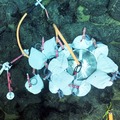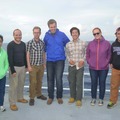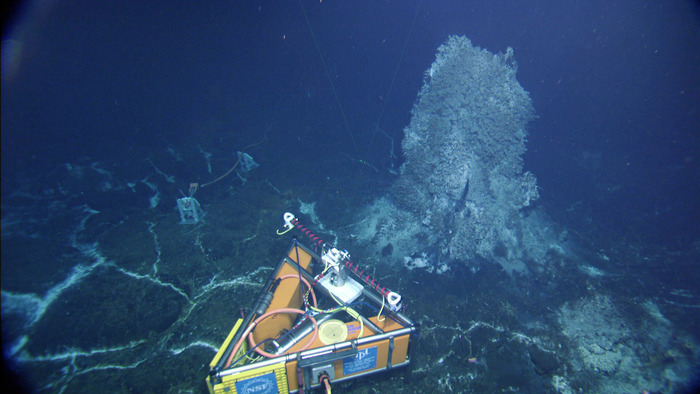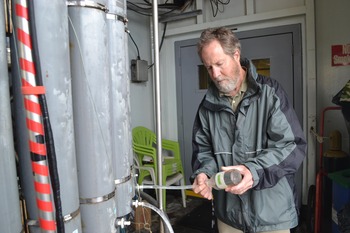I'm hopeful that the answers to questions [about the oceans ] will be discovered, giving all of us an opportunity to become better stewards of this incredible place.
29 July 2014
Today is the last day of LEG 1 and I will be heading back home. I will take with me an abundance of knowledge and experiences that I can now pass on to my students, friends, neighbors, and community members. Everything has exceeded my most imaginative expectations. I would like to give a big , big thank you to the Thomas G. Thompson for such a tremendous ride the past 18 days. You're an amazing ship with an amazing crew who are always helpful, friendly, courteous, and kind. Their professional dedication to their job and the personal interest they share with us is really what made this adventure so wonderful.
28 July 2014 (part 2!)
It's 11:00 am and tension is rising, nerves are frayed ! Will it come alive and function after sitting in the frigid, dark, lonely abyss for the past year untouched by human intervention? No one can answer that question until the switch is thrown and power is applied to a four kilometer long cable connected to the High Definition Video Camera ! This will actually be the only instrument to be plugged into power while at the ocean floor on this leg of the project. We have another camera on deck if things don't go well. However, to replace the old camera with the new one would require another dive and we are running out of time.
It's now 9:05 pm. There has been a long delay getting the power cable ROPOS uses to plug into the camera cable. ROPOS is finally plugged in and Keith pushes the switch.Oh no! Something's wrong. The camera menu has defaulted to French after all this time. Ben has to run through a program to reset all the camera settings to get back to English commands. After 45 minutes of continued anticipation the lights came on we were looking at " Mushroom " and all it's beautiful wonders in High Definition a mile down on the ocean floor. Way to go everyone! Congratulations on a job well done!
28 July 2014
Hello students at Clallam Bay School. We are finally over the site called "Ashes" which has the hydrothermal vent Mushroom. This vent has the high definition video camera that took the pictures that Deb Kelley brought to the school when she gave her talk on " Ocean Exploration and Underwater Volcanoes." Let me jog your memory! It was that eight or nine foot tower covered all over with an abundance of sea life such as tube worms, palm worms, scale worms and limpets. You were so amazed to see all those animals thriving in total darkness, never seeing the daylight.
Because there is no light at this depth photosynthesis (converting light energy into chemical energy for food ) cannot take place. In fact another process called chemosynthesis (chemical reactions in the venting fluid creating micro organisms
that provide food) takes place so that these animals can not only exist, but can heavily populate these vent sites.Remember the scale worm that waited patiently for the tube worm to come out and then he suddenly pounced and ate it? I wonder if he is still there!
27 July 2014
Sunday morning and we are waiting for repairs on ROPOS to be completed so we can begin another dive. Since things have slowed down for a bit I went on deck to enjoy the view and what do you think I saw? Water! Lots and lots of water. As far as I could see, in any direction. Besides a few clouds and the sky, there was nothing but water. How could this possibly be? Oh, now I get it. I must be on the ocean and as everyone knows the area of the World Ocean is 361 million square kilometers about 71 percent of the planet's surface).
I've been told we know more about the moon (which I'll never go to) than the ocean I am now floating on. I can believe that! In fact that is really why we're here today, to try to find answers to the questions that need to be asked so that mankind can do a better job interacting with this incredibly complex environment that in reality determines mankind's fate. Due to the visionary leadership of people like John Delaney and Deb Kelley, I'm hopeful that the answers to those questions will be discovered, giving all of us an opportunity to become better stewards of this incredible place. We need to do a much better job taking care of OUR ocean.We've only got one.
26 July 2014
Patience! Patience! Patience! This is the key operating principal for successfully accomplishing all the exceptionally complicated procedures on this project. While on watch last night from 8pm to midnight I was able to observe this principal in action first hand. The smallest detail is critical to success and cannot be overlooked. For example, just selecting an adequate landing site for ROCLS (somewhat level and not to rocky) took at least 30 minutes and precise coordination between the ship and ROPOS to accomplish. As with any complex project, things don't always go as planned. While winding up the ship's cable it became caught on the navigational pole used to gather GPS signals required for ROPOS to operate underwater. The pole had to be pulled up, the cabled untangled and the navigational software rebooted in order to proceed with the cable lay.This is just one example of the different kinds of challenges that can develop during the installation process.
25 July 2014
Several of the University of Washington students and I were helping the engineers and scientists recoil some of the fiber optic cable onto the drum carried by ROCLS (remotely operated cable laying system ) . This drum has 4.7 kilometers of cable (15,420 feet ) and will take ROPOS a minimum of eight hours to unwind the cable onto the sea floor. The total operation for this one cable lay (prep, dive, lay, return ) takes about eighteen to twenty hours. From observing all the activity that's been going on the past thirteen days I believe that is the most difficult dive for LEG 1.
24 July 2014
Yesterday's dive began at 11:00 am and was officially labeled DiVE 1722. This dive involved placing a broadband seismometer into the ROPOS tool basket, taking it down 1516 meters (over 4500 feet), removing it from the basket and deploying it at the East Caldera site to collect data on earthquake activity around Axial Volcano. Because the seismometer will be cabled, it will provide detection of earthquakes in real time. For more detailed information please go to the "instruments" tab on Interactive Oceans home page. The weather began to deteriorate resulting in wind gusts up to 30 knots and rough seas. ROPOS left the tool basket on the bottom and returned to the ship at 8:00 pm. to wait for sea conditions to improve.
22 July 2014
Observing how the instruments are prepared by the scientists and engineers, and watching ROPOS place the instruments on the ocean floor is an incredible experience for me to participate in and take back to Clallam Bay School to share with my students. Another observation I would like to share with you is the unique capabilities the ship (R/V Thomas G. Thompson) has for operating at the various sites required for this project. Because it is too deep to anchor( 4500-9000 ft) the ship has to use another way to stay on station. It does this by using bow thrusters and twin rear propellers that can pivot 360 degrees called Z drives. With these devices linked to a computer, position coordinates can be set and each propulsion system can operate independently for a brief period of time to keep the ship exactly where it needs to be.This also allows for moving the ship sideways when docking in tight places or for adjustments that are required when ROPOS is in the water. This system is so accurate that the ROV pilot can request the ship to move 4 to 5 feet in any direction when needed.
20 July 2014
We had a science meeting last night to discuss the concerns about falling behind schedule, and ways to take advantage of the weather window ( less wind and waves). General consensus was to focus on getting instruments on the bottom as quickly as possible without taking the time to plug them in because that can be done when the sea conditions worsen.We also need to get everything off the deck so the ship can be reloaded when we get into Newport with the items necessary for Leg 2. As a result ROPOS had a very busy day with three different dives. On my watch the dive plan called for placement of a shortwave seismometer to detect earthquake activity.
19 July 2014
ROPOS began another dive at 10 am and arrived at the bottom about 12:10 pm. It then began to retrieve the cable from the flange box and plug it into the J box. This was a difficult dive due to the large amount of sediment on the bottom which continually obscured the operators' view when stirred up. They had to keep stopping until the sediment settled enough for them to see, which turned a.simple operation into a difficult, time-consuming procedure. A team of five people is needed to operate ROPOS: the pilot, two navigators and one person for each of the two manipulator arms.The ROPOS Control Room is quite impressive with over seventeen monitors required to show in detail what is happening on a dive.
17 July 2014
The weather has finally improved enough for ROPOS (an under water remotely operated vehicle) to go to the bottom to survey sites that would be good for placing instruments on the seafloor. It takes about 2 hours for ROPOS to get to the bottom (depth of 2600 m) and another 2 hours to come back to the surface. They also were placing a temperature probe into several hydrothermal vents to determine how hot the venting water was. One site was averaging 190 degrees C with a top temperature of over 250 degrees C.
16 July 2014
Wind speed was around 25 knots this morning which created too rough a sea to deploy instruments.We were able to put theCTD (a round rozette of cylindars for collecting water samples) over the side and dropped it down 2500 meters to the bottom. After bringing it back, it took about 1hour for four of us to collect all of the water samples for measuring oxygen and salinity. I was also able to get some samples for the high school.
14 July 2014
Up at 5:30 am to go to a lecture presented by John Delaney, the Chief Scientist for this project. We learned about how all the different scientific instruments will be installed, and why the information is important for helping to understand how the ocean functions. The ship is rolling a lot and I am feeling a little sea sick at this moment. Watches for the ROV Dives were assigned today. I will be responsible for capturing digital still shots from noon to 4pm.
13 July 2014
My name is John Wonderly and I am a teacher at Clallam Bay School in Washington. Today is my first day at sea with the University of Washington School of Oceanography, on their journey to an underwater volcano called Axial Seamount, about 350 miles off the coast of Newport, Oregon. The trip will take about 34 hours. This is called the First Leg of their ongoing project to provide live streaming data to the Internet in the near future. After arriving over the volcano, I will be observing how they go about placing various data collection sensors on the ocean floor for the next two weeks. I can hardly wait to see the submersible robot in action. Being able to have first-hand experience to share with my students is a dream come true. Thank you, John and Deb for this unique opportunity to help my students get involved in really cool science.






